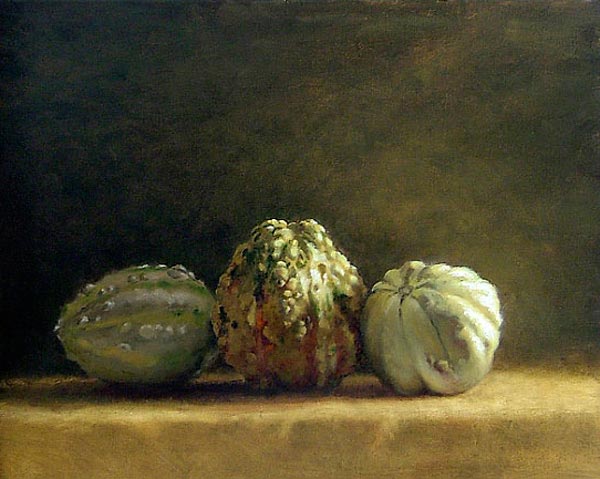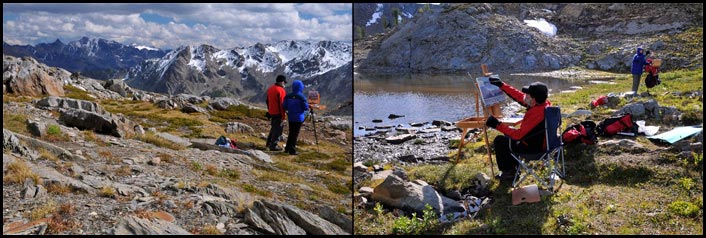Archived Comments
Enjoy the past comments below for Six exercises in magic…
I think you should have illustrated all that for those who know nothing about the golden mean, temperature, perspective and the other things you don’t mention by name! I wonder how many who will read your instructions are actually in that unfortunate situation? Not that I don’t agree with going back to basics……..
Faith sounds as if she is a member of the Wailing Wall. Go find out yourself what temperature etc. means. If you don’t have the fortitude to do this, you will never become a decent painter. On the net alone, you can do this. Soon you will want ‘someone to chew your food’ for you, Faith . . . this is an expression in the poor African country I am working in. There is such poverty that many will be happy to chew for you. To read your request for an artistic nanny is pitiful.
Thank you for those exercises and I will certainly try to do them. I have a question; some of my colleagues said that try to avoid using black or white to achieve dark or light areas. So what color combination would you recommend to achieve the effects and what is the proportion of each color used? It is great to get some exercises like these once in while for me as an amateur I am struggling in mixing colors.
I love this letter on magic. Thank you for writing it and sending it out to us.
I loved this topic and the suggestions to improve painting skills. Please post more ideas and show us the results that other readers have created and submitted as well.
Experiments…. A land of Milk & Honey flows… across the art world into pure silence of morning- Experiment, always in hope of a better world Acceptance as artists, simply creating and true realization that , leaving art behind is fulfillment, enough…Love, Paula http://paulaspoetryworld.blogspot.com
Robert, could you please explain ‘copacetic’ to me. I looked it up in the dictionary and was not quite sure what you meant by it. The dictionary talks about ‘coparcenary’ or ‘coparcener’ meaning joint ownwership – so what is ‘copacetic’? Participating?
For Edna, Stapleton Kearns just put up a good clear review about colour and mixing on his blog. Here is the link http://stapletonkearns.blogspot.com/2010/09/review-of-color-wheel.html Just put out some colours. I used phthalo blue, ultramarine blue, quinacridone rose, cadmium red light, hansa yellow light, cadmium yellow medium and burnt sienna, plus titanium white if using oils) and play with them. For watercolour, white is the white of the paper that you preserve when planning your painting. Have fun mixing away.
I just had another thought, something that I learned from the best instructors. Only use the best quality paints, ie artist quality, not student quality, or paints that say ‘hue’. Student quality paints have much less pigment, and often had white or fillers added. You can never get the intensity you want with them and mud is very easy to achieve so it is hard to get anywhere other than frustrated with them.
‘Copacetic’, that under-utilized, uber-cool word means that everything or everybody is getting along well together, and groovin’ just fine, as I understand it!!
Ah Thierry – it’s all in the mind. I did not state that I myself know nothing about the golden mean or the other elements and I am certainly not a wailing wall. On the contrary, I’m overjoyed about all this stuff. But I do have a point because not everyone who reads such a list (and actually sets about obeying it) is a fully fledged visual artist. The fact that some have responded with a degree of puzzlement does rather prove my point…… You could read some of my other letters here or look at my quotes to get a better idea of how I “tick”. As a judge of character, you really are a non-starter.
For Edna, to make a dark colour without black, I always mix pthalo blue and burnt sienna. It makes a beautiful dark.
If you have to have something demonstrated to you, you are too lazy to work it out for yourself. Seeing demos does not build skills. Working on your own, privately, is the key to progress.
Thierry, Mirriam, what happen to people lately, why are you being offensive, did you forget your humble beginnings? If this is the road this blog will take: it’s doommed! …and you are also being offensive toward Robert! Art is supposed to be shared, nurtured. Let others be themselves!!
You can feed the hungry, but you can’t fix stupid. You can recognize stupid – they always search for someone stupider than themselves.
The good far outweighs the bad, and, in a way, it is good to hear ugly opinions. They convince you that there is much good in our world.
Those of us who are readers of James Lee Burke’s fine mystery novels know instinctively what “copacetic” means. But I looked it up in my ancient Webster’s New Collegiate to see what it said. According to the dictionary, it means “very satisfactory”, though I prefer Carole’s more poetically stated definition. As Burke’s character Clete Purcell would say, “Everything’s copacetic, mon, stay cool.” Good return, Faith.
copacetic means ok – fine – everything is as it should be. If your dictionary doesn’t have it, maybe it is time for a new dictionary. It’s a word that was used a lot in the ’70’s. That dates me.


Lightplay oil painting by Cindy Revell, AB, Canada |











Love the painting. Medium? Bon Voyage on your painting trip, sounds exciting, and as you say, exhilarating and free-ing. You may not complete anything you love at the moment of execution, but the experience will open a door to a whole new direction in the weeks and months to come. Like jumping off a cliff (but with a happy landing).